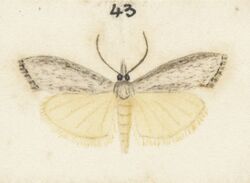Biology:Orocrambus sophronellus
| Orocrambus sophronellus | |
|---|---|

| |
| Illustration of male | |
| Scientific classification | |
| Domain: | Eukaryota |
| Kingdom: | Animalia |
| Phylum: | Arthropoda |
| Class: | Insecta |
| Order: | Lepidoptera |
| Family: | Crambidae |
| Subfamily: | Crambinae |
| Tribe: | Crambini |
| Genus: | Orocrambus |
| Species: | O. sophronellus
|
| Binomial name | |
| Orocrambus sophronellus (Meyrick, 1885)[1]
| |
| Synonyms[2] | |
| |
Orocrambus sophronellus is a moth in the family Crambidae. This species is endemic to New Zealand. This species has been classified as Data Deficient by the Department of Conservation.
Taxonomy
This species was first described by Edward Meyrick in 1885,[3] from a specimen given to him by Richard William Fereday.[4] Meyrick named the species Crambus sophronellus.[2][3] Meyrick gave a more detailed description of the species later that year.[4] In 1928 George Vernon Hudson also described and illustrated the species.[5] In 1975 David E. Gaskin placed the species in the genus Orocrambus.[6] Gaskin argues that Hudsons illustration in his 1928 book is actually of the species O. cyclopicus.[6] The type locality of the specimen is uncertain but is possibly Canterbury.[3] The type specimen is held at the Natural History Museum, London.[2]
Description
Meyrick described the species as follows:
Female. — 19 mm. Head and thorax ochreous-white, coarsely irrorated with greyish-fuscous. Palpi long, whitish, externally irrorated with grey. Antennae grey. Abdomen whitish, irrorated with grey. Legs grey-whitish. Forewings elongate, tolerably oblong, costa hardly arched, apex round-pointed, hindmargin straight, rather strongly oblique ; greyish-fuscous, densely irrorated with white, and with a few black scales : cilia whitish-grey mixed with white, base white. Hindwings light fuscous-grey, towards hindmargin darker ; cilia grey- whitish.[4]
Distribution
This species is endemic to New Zealand.[1][7] It has been recorded in Taparewa near Nelson,[5] the Mackenzie Basin,[8] and Central Otago.[6] It is possibly also present in Canterbury.[6]
Life cycle and behaviour
Adult moths have been recorded on wing in March.[6] The species is attracted to light.[5]
Habitat
O. sophronellus is thought to occur in short tussock grasslands.[9]
Host species
O. sophronellus is associated with Carex muelleri.[10]
Conservation status
This moth is classified under the New Zealand Threat Classification system as being Data Deficient.[11]
References
- ↑ 1.0 1.1 "Orocrambus sophronellus (Meyrick, 1885)". Landcare Research New Zealand Ltd. http://www.nzor.org.nz/names/fe7a067a-8328-4d3f-abd4-d2173d99441e. Retrieved 22 January 2018.
- ↑ 2.0 2.1 2.2 Dugdale, J. S. (1988). "Lepidoptera - annotated catalogue, and keys to family-group taxa". Fauna of New Zealand 14: 149. https://www.landcareresearch.co.nz/__data/assets/pdf_file/0017/26324/FNZ14Dugdale1988.pdf. Retrieved 1 May 2018.
- ↑ 3.0 3.1 3.2 Meyrick, Edward (1885). "Description of New Zealand Microlepidoptera. V [VI. Pyralidina [abstract]."] (in en). New Zealand Journal of Science 2: 346–348. https://biodiversitylibrary.org/page/41863431.
- ↑ 4.0 4.1 4.2 Meyrick, Edward (1885). "Descriptions of New Zealand Microlepidoptera. VI. Pyralidina." (in en). Transactions and Proceedings of the New Zealand Institute 17: 121–140. https://biodiversitylibrary.org/page/33934568.
- ↑ 5.0 5.1 5.2 Hudson, G. V. (1928). The Butterflies and Moths of New Zealand. Wellington: Ferguson & Osborn Ltd.. pp. 169. http://www.bugz.org.nz/WebForms/ResultDetails.aspx?CurrentDoc=C7E94865-492F-45DA-9777-CC8E1E8B1438&back=true&NewDoc=true&searchType=1&SearchString=G.V.+Hudson.
- ↑ 6.0 6.1 6.2 6.3 6.4 Gaskin, D. E. (10 March 1975). "Revision of the New Zealand Crambini (Lepidoptera: Pyralidae: Crambinae)". New Zealand Journal of Zoology 2 (3): 265–363. doi:10.1080/03014223.1975.9517878.
- ↑ , p. 457, Wikidata Q45922947
- ↑ Head, Nicholas John (4 October 2016). "Statement of evidence of Nicholas John Head for the Director-General of Conservation.". https://www.ecan.govt.nz/document/download?uri=3008170.
- ↑ Pawson, Stephen M; Emberson, Rowan M (2000) (in en). The conservation status of invertebrates in Canterbury (Report). Lincoln University.
- ↑ "Nevis Red Tussock Fen" (in en). Otago Regional Council. https://www.orc.govt.nz/managing-our-environment/water/regionally-significant-wetlands/central-otago-district/nevis-red-tussock-fen. Retrieved 6 May 2018.
- ↑ Hoare, R.J.B.; Dugdale, J.S.; Edwards, E.D.; Gibbs, G.W.; Patrick, B.H.; Hitchmough, R.A.; Rolfe, J.R. (2017). Conservation status of New Zealand butterflies and moths (Lepidoptera), 2015. Wellington, New Zealand: New Zealand Department of Conservation. pp. 5. ISBN 9781988514383. http://www.doc.govt.nz/Documents/science-and-technical/nztcs20entire.pdf.
External links
- Image of female holotype specimen
- Image of male and female species
- Specimen held by Auckland War Memorial Museum
Wikidata ☰ Q13965519 entry
 |

